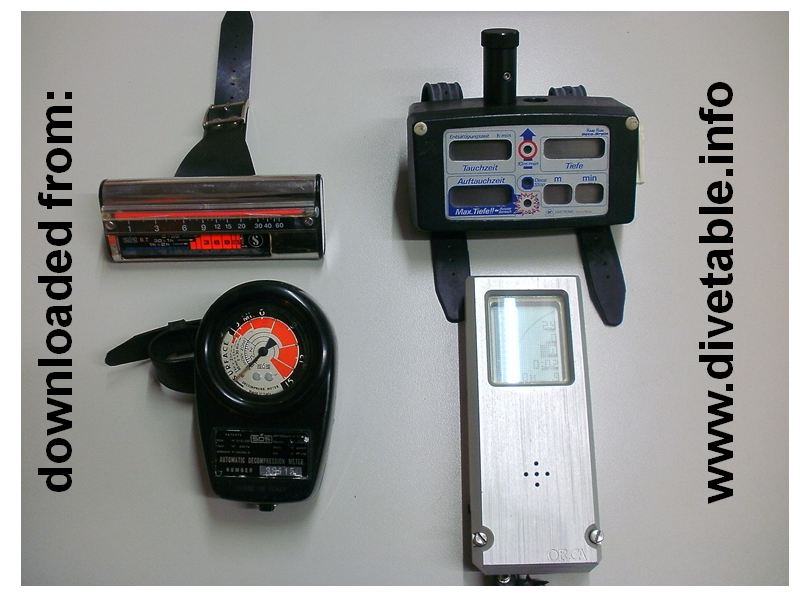- was swiss made by DIVETRONIC, later Keller Drucktechnik
- reliable and really commercial available
- it really worked up to 100
- you could re-charge it during normal operation
- and did accompany me for a couple of hundred dives before it became leaky
- the algorithm was well documented in the manual and extremly stable implemented
- but only with the 2nd release, after Version 2-1
- at the famous AQUASPORT beach in Elat/Israel we did our own "compatibility" testing in the 80's
- a fly-dive to 70 or 80 within 3 minutes, then we went slowly up, finally starting with deep stops around 40 or 30,
- then we moved slowly up to the first calculated deco stop at 21 or so ...
- when we arrived 3 m, we had approx. 30 minutes deco left (after the third dive in consequence)
- we made it up to 10 or 15 mins., became cold and fed-up then left the DECO BRAIN decompress itself in 3 mtrs. and
- squaffing down some beers in the meantime, then we pulled it out and attached it to the re-charging unit
- in order to make the same thing the next day, and then we repeated the schedule approx. 20 days!
- (my friend and I we are still alive ...)
- and thus one of my israeli friends, David Vered, learned his first german word for a fly-dive (FLUG TAUCHEN) ...

- from left to right you see the two chip-prints, layered on each other in the housing,
- and the piezo-resistive pressure sensor with it's circuit scheme
- on the EPROM you see the software version label: P2-2,
- mentioned above was the predecessor P2-1 which was just a silly interpolation tool:
- which handled multi-level dives with an untested and undocumented procedure:
- from the stored ZH-L tables of the traditional square-profiles
- and the corresponding repetitive groups of the 80 min. compartment the multi-level dive times had been derived.
- So P2-2 was the first full blown ZH-L 16 implementation, with the coefficients from
- the famous 1983 publication of Prof. A. A. Buehlmann (pls. cf. my literature list: [4], [5] and [65]).
- During 1984 these coeffcients became adapted a couple of times, as well through Dr. Max Hahn
- so this P2-2 became replaced very quickly by P2-3 due to some slight DCS incidences
- we never used P2-3 because we didn't have any problem at all (please cf. the EILAT story)
- this is what decompression is all about: some guys do have problems with a certain profile,
others never, others sometimes ...
- when I was in Eckernfoerde (northern germany) I used to know a poor guy, who got bends after every dive!
- even after dives like 20 min./ 15 mt.: so he was dismissed from the combat divers group
- attached to a diver it looked like that ....

- this picture shows me after a dive in the lake of Constance in the 80's
- d' ya see what? That time we used two of everything: 25 years later this is now called
- redundancy and technical diving
- the little Heuer watch (swiss made, as well) is still o.k.
- my last DECO BRAIN gave around 1986 during our notorious XMAS dive trips to Spain ... what a pity!!!

- here you see the display in detail
- Tauchzeit = dive time, Tiefe = depth, Auftauchzeit = total ascent time (= sum of all deco-stops + ascent = tts)
- Entsaettigungszeit = desaturation time, Max. Tiefe = maximum depth, ausser Bereich = out of range (with one blinking LED)
- the middle LED was blinking during the deco-stops, the top one was an alarm LED for ascent speed
- i still have the manual for it ...
- as well there was a really unique thing available: a bolt to simulate pressure
- it was attached to the piezo, thus allowing for simulating a dive:

- (picture taken from the manual)
- the manual
- and here, in direct comparison with historical hardware!

- left: pneumatical gadgets, down the SOS Deco-Egg, above one of the countless followers, here from Scubapro
- right: above the Deco-Brain (with the pressure bolt, but without the Akku-Pack), down: Orca EDGE
back to: Contents
back to: DIVE TABLES homepage







